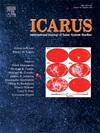Magnetic topology dependence of ionizing electrons on the Martian nightside ionosphere
IF 2.5
2区 物理与天体物理
Q2 ASTRONOMY & ASTROPHYSICS
引用次数: 0
Abstract
The interaction between the solar wind and Martian crustal magnetic fields plays a significant role in shaping electron precipitation in the ionosphere, particularly on the nightside. Using five years of data from the Mars Atmosphere and Volatile EvolutioN (MAVEN) spacecraft, this study explores how magnetic topology influences the distribution of ionizing electrons, quantified through the electron impact ionization frequency (EIIF). Data from MAVEN's Solar Wind Electron Analyzer (SWEA) and magnetometer (MAG) were analyzed, with strong and weak crustal field regions defined at observation altitudes using a crustal field model. As expected, the results demonstrate that magnetic topology critically influences the altitude distribution of EIIF on the nightside. However, variations in EIIF across the terminator reveal dynamic and novel patterns. In open and draped topologies, EIIF decreases gradually from the dayside, across the terminator, and onto the nightside. Conversely, closed topologies exhibit a sharper decrease in EIIF across the terminator, characterized by strong altitude dependence. This is attributed to day-to-night transport along cross-terminator closed field lines. Below 600 km on the nightside, EIIF in closed topologies is up to two orders of magnitude lower than in open and draped topologies due to the shielding effect of crustal fields, with stronger shielding observed at lower altitudes. Above 240 km, EIIF in open and draped topologies shows no dependence on crustal field strength and weak dependence on solar wind dynamic pressure (Psw). In contrast, the EIIF in closed topologies shows a strong dependence on magnetic field strength and a weak dependence on Psw. These findings provide critical insights into the role of magnetic topology in electron precipitation, aiding the parameterization of electron dynamics in global circulation models of the Martian ionosphere.
火星夜侧电离层电离电子的磁拓扑依赖性
太阳风和火星地壳磁场之间的相互作用在形成电离层的电子沉淀中起着重要作用,特别是在夜侧。利用来自火星大气和挥发性演化(MAVEN)航天器的五年数据,本研究探索了磁拓扑如何影响电离电子的分布,通过电子撞击电离频率(EIIF)进行量化。分析了MAVEN太阳风电子分析仪(SWEA)和磁力计(MAG)的数据,并使用地壳场模型在观测高度定义了强和弱地壳场区域。正如预期的那样,结果表明磁拓扑结构对夜侧EIIF的高度分布有重要影响。然而,EIIF在终端上的变化揭示了动态和新颖的模式。在开放和覆盖的拓扑结构中,EIIF从白天开始逐渐减少,穿过明暗界限,最后到达夜晚。相反,闭合拓扑在终端上表现出更明显的EIIF下降,其特征是高度依赖性强。这归因于沿交叉界线闭合场线的日夜运输。在600公里以下的夜侧,由于地壳场的屏蔽作用,封闭拓扑中的EIIF比开放和覆盖拓扑中的EIIF低两个数量级,在较低海拔处观察到更强的屏蔽作用。在240 km以上,开放和覆盖拓扑的EIIF对地壳场强没有依赖性,对太阳风动压(Psw)的依赖性较弱。相反,闭合拓扑中的EIIF对磁场强度的依赖性较强,对Psw的依赖性较弱。这些发现对磁拓扑在电子沉淀中的作用提供了重要的见解,有助于火星电离层全球环流模型中电子动力学的参数化。
本文章由计算机程序翻译,如有差异,请以英文原文为准。
求助全文
约1分钟内获得全文
求助全文
来源期刊

Icarus
地学天文-天文与天体物理
CiteScore
6.30
自引率
18.80%
发文量
356
审稿时长
2-4 weeks
期刊介绍:
Icarus is devoted to the publication of original contributions in the field of Solar System studies. Manuscripts reporting the results of new research - observational, experimental, or theoretical - concerning the astronomy, geology, meteorology, physics, chemistry, biology, and other scientific aspects of our Solar System or extrasolar systems are welcome. The journal generally does not publish papers devoted exclusively to the Sun, the Earth, celestial mechanics, meteoritics, or astrophysics. Icarus does not publish papers that provide "improved" versions of Bode''s law, or other numerical relations, without a sound physical basis. Icarus does not publish meeting announcements or general notices. Reviews, historical papers, and manuscripts describing spacecraft instrumentation may be considered, but only with prior approval of the editor. An entire issue of the journal is occasionally devoted to a single subject, usually arising from a conference on the same topic. The language of publication is English. American or British usage is accepted, but not a mixture of these.
 求助内容:
求助内容: 应助结果提醒方式:
应助结果提醒方式:


